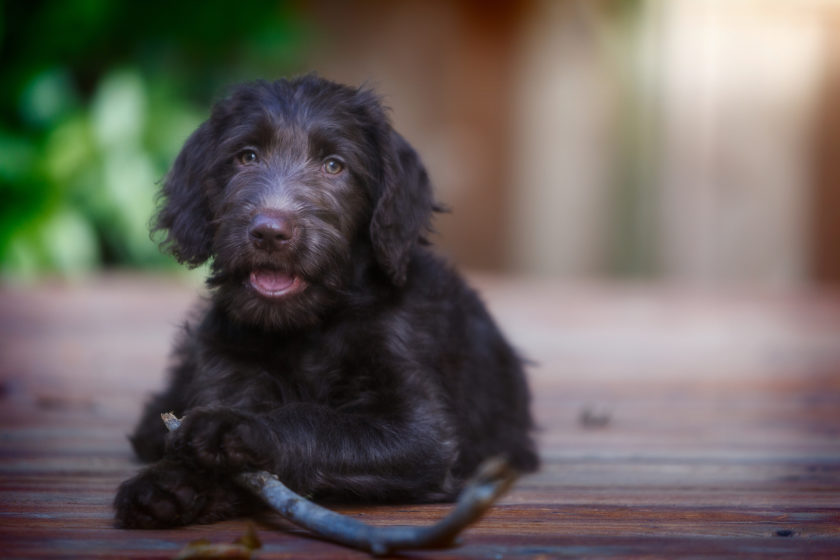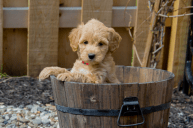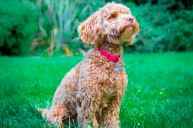Everywhere you look, there are oodles of doodles! In the last ten years or so, there has been a doodle explosion and the affectionate dog breed has taken center stage as one of the world's go-to pets. This designer breed takes a poodle, in either a standard, medium, or miniature size, and mixes it with another popular dog breed, like a Labrador retriever. A couple of examples other than labradoodles are the goldendoodle, boxerdoodle, and the cavapoo.
The very first labradoodle was created in 1980 by Wally Conron, the puppy-breeding manager for the Royal Guide Dog Association of Australia. He wanted to create a hypoallergenic dog for a visually impaired woman because her husband was highly allergic to dog hair. It took dozens of attempts (33 to be exact!) over several years before the first litter of labradoodles was finally born.
The idea behind the labradoodle was to make a crossbreed that's low-shedding and allergy-friendly. Hypoallergenic dog breeds are the best way for animal lovers to still have a pup to call their own without suffering from health problems. But, wait—does such a thing even exist? And are labradoodles hypoallergenic? The answer is more complicated than you'd think!
Are Labradoodles Hypoallergenic?

Are labradoodles really hypoallergenic? The answer is complicated. A purebred poodle is known for its low-shedding coat that produces less dander than other dogs. Meanwhile, Labrador retrievers are praised for their friendly demeanor and trainability, but they tend to shed a lot. Put the two together, and you'd think you'd have a pooch that has the best of both worlds: a low-maintenance coat and a great personality. Unfortunately, it's not always that simple.
"Many owners purchase labradoodles because they want low-shedding dogs, however, they are actually not considered a hypoallergenic breed," Dr. Courtnye Jackson, DVM, tells WideOpenPets.com. "There are actually no 100% hypoallergenic dogs, there are just dogs that are less allergenic for people with allergies."
Because of their poodle DNA, it's true that labradoodles don't shed very much and the labradoodle coat is relatively low-maintenance. However, allergens don't just live in pet dander. They can be found in saliva and even in dogs' urine. While some labradoodles may be close to being hypoallergenic, it's unlikely that every pup in the litter is the same.
"Allergy-friendly labradoodles are those with coats they inherited from their poodle parent," Jackson explains. "There are three types: 'wool coated' (thick), 'fleece coated'(soft), and 'flat coated' (wiry)."
Sounds complicated, right? A wool coat type is allergy-friendly and has the same type of texture as a standard poodle. A labradoodle with a fleece coat is the most common and best if you have severe allergy symptoms or asthma, because these pups don't shed at all. If your labradoodle puppy ends up with a flat coat, it is not considered allergy-friendly at all. The texture of the hair can be wiry or even straight like a purebred lab, and there's no guarantee that dogs with these coats won't shed.
How Much Does a Labradoodle Cost?

Costs can vary if you're looking to add a labradoodle to your family, but they tend to be expensive. The price of a labradoodle puppy can range anywhere from $500 to more than $3,000. Most labradoodle breeders require a deposit to choose a pup, and you may even have to fill out an application. While the labradoodle is a crossbreed that's not recognized by the American Kennel Club, the pups can be registered with the Australian Labradoodle Association of America.
Where to Get a Labradoodle

Before heading to a breeder, it's a great option to check your local shelter or pet rescue to see if they have any labradoodles waiting for a home. You can also search your area for labradoodle rescues who specialize in rehoming and fostering pups who did not work out in their original homes. There are likely plenty of options that will fit your needs and these dogs are often less expensive than going through a breeder.
However, if you can't find the dog of your dreams through a shelter or rescue, you can find a reputable breeder in your area. (Just be sure to do your research and avoid puppy mills!) You can also look on the Australian Labradoodle Association of America's website to find a registered breeder near you. The ALAA was established in 2004 to protect Labradoodles.
Do you have a Labradoodle? Show us on our Wide Open Pets Instagram!




